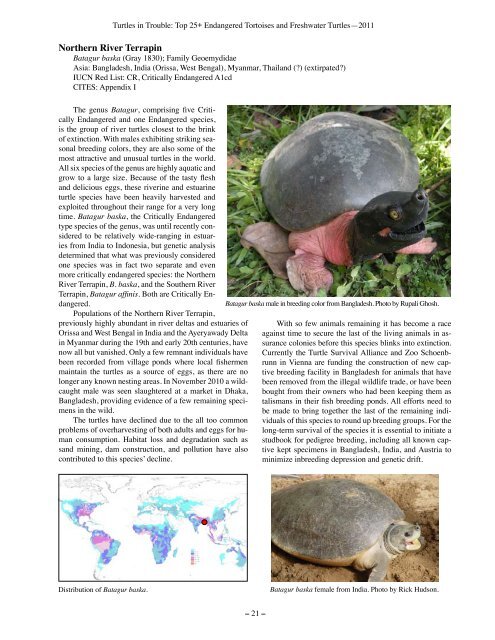Turtles in Trouble: The World's 25+ Most Endangered - Wildlife ...
Turtles in Trouble: The World's 25+ Most Endangered - Wildlife ...
Turtles in Trouble: The World's 25+ Most Endangered - Wildlife ...
- No tags were found...
You also want an ePaper? Increase the reach of your titles
YUMPU automatically turns print PDFs into web optimized ePapers that Google loves.
<strong>Turtles</strong> <strong>in</strong> <strong>Trouble</strong>: Top <strong>25+</strong> <strong>Endangered</strong> Tortoises and Freshwater <strong>Turtles</strong>—2011Northern River Terrap<strong>in</strong>Batagur baska (Gray 1830); Family GeoemydidaeAsia: Bangladesh, India (Orissa, West Bengal), Myanmar, Thailand (?) (extirpated?)IUCN Red List: CR, Critically <strong>Endangered</strong> A1cdCITES: Appendix I<strong>The</strong> genus Batagur, compris<strong>in</strong>g five Critically<strong>Endangered</strong> and one <strong>Endangered</strong> species,is the group of river turtles closest to the br<strong>in</strong>kof ext<strong>in</strong>ction. With males exhibit<strong>in</strong>g strik<strong>in</strong>g seasonalbreed<strong>in</strong>g colors, they are also some of themost attractive and unusual turtles <strong>in</strong> the world.All six species of the genus are highly aquatic andgrow to a large size. Because of the tasty fleshand delicious eggs, these river<strong>in</strong>e and estuar<strong>in</strong>eturtle species have been heavily harvested andexploited throughout their range for a very longtime. Batagur baska, the Critically <strong>Endangered</strong>type species of the genus, was until recently consideredto be relatively wide-rang<strong>in</strong>g <strong>in</strong> estuariesfrom India to Indonesia, but genetic analysisdeterm<strong>in</strong>ed that what was previously consideredone species was <strong>in</strong> fact two separate and evenmore critically endangered species: the NorthernRiver Terrap<strong>in</strong>, B. baska, and the Southern RiverTerrap<strong>in</strong>, Batagur aff<strong>in</strong>is. Both are Critically <strong>Endangered</strong>.Populations of the Northern River Terrap<strong>in</strong>,previously highly abundant <strong>in</strong> river deltas and estuaries ofOrissa and West Bengal <strong>in</strong> India and the Ayeryawady Delta<strong>in</strong> Myanmar dur<strong>in</strong>g the 19th and early 20th centuries, havenow all but vanished. Only a few remnant <strong>in</strong>dividuals havebeen recorded from village ponds where local fishermenma<strong>in</strong>ta<strong>in</strong> the turtles as a source of eggs, as there are nolonger any known nest<strong>in</strong>g areas. In November 2010 a wildcaughtmale was seen slaughtered at a market <strong>in</strong> Dhaka,Bangladesh, provid<strong>in</strong>g evidence of a few rema<strong>in</strong><strong>in</strong>g specimens<strong>in</strong> the wild.<strong>The</strong> turtles have decl<strong>in</strong>ed due to the all too commonproblems of overharvest<strong>in</strong>g of both adults and eggs for humanconsumption. Habitat loss and degradation such assand m<strong>in</strong><strong>in</strong>g, dam construction, and pollution have alsocontributed to this species’ decl<strong>in</strong>e.Batagur baska male <strong>in</strong> breed<strong>in</strong>g color from Bangladesh. Photo by Rupali Ghosh.With so few animals rema<strong>in</strong><strong>in</strong>g it has become a raceaga<strong>in</strong>st time to secure the last of the liv<strong>in</strong>g animals <strong>in</strong> assurancecolonies before this species bl<strong>in</strong>ks <strong>in</strong>to ext<strong>in</strong>ction.Currently the Turtle Survival Alliance and Zoo Schoenbrunn<strong>in</strong> Vienna are fund<strong>in</strong>g the construction of new captivebreed<strong>in</strong>g facility <strong>in</strong> Bangladesh for animals that havebeen removed from the illegal wildlife trade, or have beenbought from their owners who had been keep<strong>in</strong>g them astalismans <strong>in</strong> their fish breed<strong>in</strong>g ponds. All efforts need tobe made to br<strong>in</strong>g together the last of the rema<strong>in</strong><strong>in</strong>g <strong>in</strong>dividualsof this species to round up breed<strong>in</strong>g groups. For thelong-term survival of the species it is essential to <strong>in</strong>itiate astudbook for pedigree breed<strong>in</strong>g, <strong>in</strong>clud<strong>in</strong>g all known captivekept specimens <strong>in</strong> Bangladesh, India, and Austria tom<strong>in</strong>imize <strong>in</strong>breed<strong>in</strong>g depression and genetic drift.Distribution of Batagur baska.Batagur baska female from India. Photo by Rick Hudson.– 21 –







![RaLand / SeaScape [PDF] - Wildlife Conservation Society](https://img.yumpu.com/49974326/1/190x245/raland-seascape-pdf-wildlife-conservation-society.jpg?quality=85)








